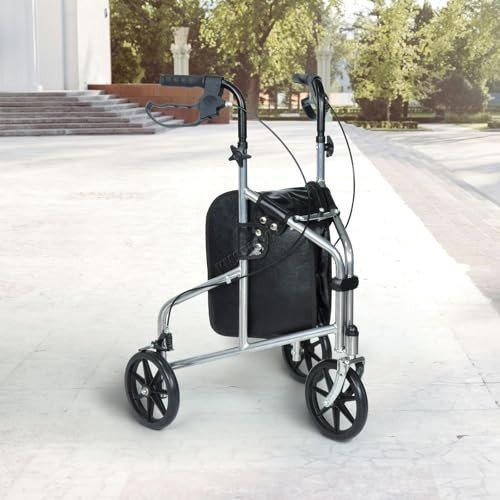
3
MayWalking Frame: The Good, The Bad, And The Ugly
Understanding Walking Frames: Features, Benefits, and Considerations
Walking frames, also understood as walkers, are important mobility aids designed to supply stability and assistance for individuals who may deal with balance, coordination, or strength when moving. These devices can significantly boost the quality of life for the elderly, people recovering from surgical treatment, and those with persistent health conditions affecting mobility. This short article will look into the various types of walking frames, their benefits, correct use, and key factors to consider for users and caretakers.
Types of Walking Frames
Walking frames been available in several variations to accommodate different user needs. The primary types consist of:
Standard Walking Frames: These are basic freestanding frames that provide optimal stability. Users need to raise the frame with each step, making them appropriate for individuals with excellent upper body strength.
Two-Wheeled Walkers: These frames have 2 front wheels, permitting smoother movement. They are perfect for users who can handle some weight-bearing and require less lifting.
Four-Wheeled Walkers (Rollators): Designed with 4 wheels, a seat, and hand brakes, rollators use convenience and safety. Users can stroll without lifting the frame, making them suitable for those with minimal stamina or strength.
Knee Walkers: These are created for individuals recuperating from foot or rollator for seniors ankle injuries. Users rest their knee on a cushioned cushion while pressing themselves forward with their other leg.
Table 1: Comparison of Walking Frame Types
| Walking Frame Type | Main Features | Best Suited For |
|---|---|---|
| Basic Walking Frame | No wheels; requires raising | Users with excellent upper body strength |
| Two-Wheeled Lightweight Tri Walker Rollator: Easy Mobility & Comfort | Front wheels; easier maneuvering | Users needing moderate assistance |
| Four-Wheeled helavo heavy duty All-Terrain Walker with Flat-Free Tires – Buy Now! walker For seniors (www.mymobilityscooters.uk) | Wheels, seat, brakes | Users needing stability and rest options |
| Knee Walker | Cushioned knee rest; mobile | Users with lower leg injuries |
Benefits of Using Walking Frames
Walking frames use numerous benefits that enhance mobility and promote independence. These benefits include:
Increased Stability: Walking frames provide a stable platform, lowering the risk of falls.
Improved Confidence: By offering support, users can feel more protected while walking, which enhances their self-confidence in mobility.
Versatile Use: Walking frames can be utilized inside and outdoors, accommodating different surfaces and environments.
Lowered Physical Strain: They alleviate the physical burden on the user's legs and back, allowing individuals with discomfort or weak point to stroll longer distances.
Encouragement of Physical Activity: Regular use can promote mobility and assistance preserve physical activity, which is essential for general health.
Key Considerations for Users and Caregivers
While walking frames provide significant benefits, there are several essential considerations to ensure ideal use:
Proper Fit: Walking frames should be changed to the appropriate height for the user. When standing straight, the elbows need to be slightly bent when holding the manages.
Weight Capacity: Each walker has a maximum weight limitation. Users ought to ensure they choose a walking frame that can sufficiently support their weight.
Terrain Suitability: Users need to think about where they will mostly use the walker. Four-wheeled walkers are much better matched for outdoor use on uneven surfaces.
Maintenance: Regular look at brakes, wheels, and structural integrity are required to ensure safety.
User Training: Proper training from health care professionals can assist users and caregivers understand how to use walking frames safely and successfully.
FAQs about Walking Frames
Who can gain from utilizing a walking frame?
- Individuals with balance problems, elderly people, those recuperating from surgical treatment, and those Rollator With Wheels persistent mobility issues can take advantage of using walking frames.
Can walking frames be utilized outdoors?
- Yes, many walking frames, specifically four-wheeled walkers, are created for both indoor and outdoor use.
How do I choose the best walking frame?
- Consider your mobility needs, environment, weight capability, and any additional features like seats or storage compartments.
What should I do if I feel unsteady using a walking frame?
- Seek advice from a healthcare expert or physical therapist for guidance on proper usage and change of the walking frame.
Are there any dangers associated with utilizing a Walking Aids frame?
- If not utilized correctly, walking frames might cause falls. It's crucial to ensure proper fit, change them properly, and practice safe walking strategies.
Walking frames represent an important tool for increasing mobility and independence for many individuals facing physical difficulties. By understanding the different types readily available, their benefits, and the considerations included in their use, users and caretakers can make informed choices about choosing and making use of the right walking frame. With the best support, numerous individuals can gain back self-confidence in their mobility, improve their quality of life, and take necessary steps towards self-reliance.



Reviews